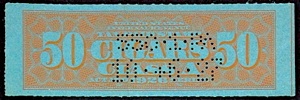Easily Dating Cigar Boxes
A Hyman’s Cigar History Museum Exclusive
© Tony Hyman, All Rights reserved
Minor text change: December 12, 2011

Easily Dating Cigar Boxes
A Hyman’s Cigar History Museum Exclusive
© Tony Hyman, All Rights reserved
Minor text change: December 12, 2011
1878 - 1909
Between 1863 and 1878 dozens of cigar tax stamps had been issued, most of which you’ll never run into. They’re covered in detail elsewhere.
EASY DATING begins with what you will find, the four very similar issues of 1878, 1883, 1898 and 1901. These four issues are on boxes of the Golden Age. The main difference between the four years of issue is the positioning of the date.
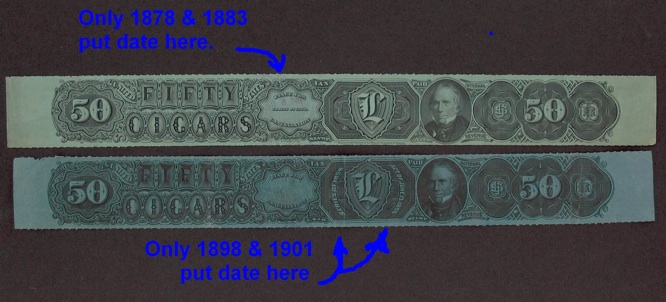
It’s easy to date U.S. cigar boxes because Congress constantly changed tax laws. Changes often required something to be printed or pasted on a box. For quickie dating, the three most useful things on a box are:
[1] Revenue (tax) stamps [2] Caution Notices [3] Tax paid notices.
With a few basic facts about each, you will be able to date most boxes at a glance. Dating means putting the box in the correct historical period, not learning the exact day it left the factory, though that too is sometimes possible. This is a simple overview. Each of these topics is detailed elsewhere in Hyman’s Cigar History Museum.
REVENUE STAMPS:
Whenever possible begin dating with the revenue stamp. The stamp allows you to accurately put a box into one of five historic periods:
1863-1877 Pre Golden Age
1878-1909 Golden Age
1910-1915 Late Golden Age
1916-1941 Machine Age
1942-1959 Post WWII era
The stamps you are about to see are the most common types. They are very distinct in size, shape and color. With experience, you can tell if a stamp is one of the most common types from across a room. Close up, a small fragment is often enuff to date a box.
A 100 stamp wraps all four sides of this 1881 wooden box.
1910 - 1915
Stamps from 1910-1915 are black on medium blue, and noticeably thinner and 4 inches shorter. As a result they usually wrap on three sides of a box: front, top and back but not the bottom.
Late Golden Age stamps are dated 1909 and 1910 but were
used until stamp design was totally changed again in 1916.
This shows the longer 100 denomination wrapped on three sides of a box. This distinctive stamp was used for only five years so is a big help in dating. Remember, clues in this chapter are clues to quick dating only. For detail see elsewhere.
The orange stamp is a private issue and of questionable help.
1916 - 1942
These stamps wrap only on the top and front of a box and are easily recognized. When you see one, think 1920’s or 1930’s. Dates change in 1916. 1917, and 1926. If the stamp has a series number after the 1926 date like the one illustrated, the stamp dates after 1931. Add the last two numbers of the Series to 1930 and you’ll know the date. This one is 1933. The red hand cancellation reads 1933 as well. Cancellations can be a good date clue, but are not always accurate.
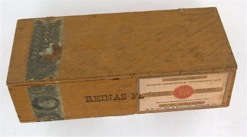
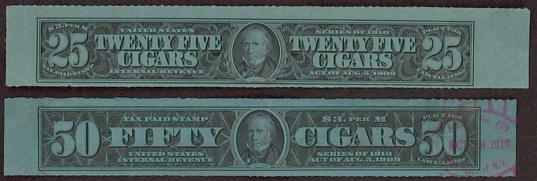

TAX CLASS NOTICE
After 1917 a Tax Class Notice is required to be on the front or bottom of every box for the next 50 years. There’s no easier way to tell at a glance whether a box is before 1917 or after 1917. Golden Age boxes don’t have tax paid notices. Machine age (1917-1959) boxes do. Modern (after 1960) boxes don’t.
if a tax class notice is pasted on and does not mention the price of the cigars, it dates 1917-1919. If the tax class notice is printed on and gives a range of selling prices, it dates 1919-1959.
OLD ABE is a very typical 1920’s box. You can see the Tax Class Notice on the right and the orange on blue tax stamp (1917-1942) on the left. Front or bottom, if there’s a Tax Class Notice on the box it can’t date before 1917.
1917-1919
On the front, usually pasted on
Nickel cigars were Class A
Dime cigars were Class C
Retail price of cigars not given
1919-1942
Printed on the front or bottom
Nickel cigars were Class A
Dime cigars were Class C
Cuban cigars were Class E
1942-1960
Printed, usually on the bottom
Nickel cigars were Class C
Dime cigars were Class E
Cuban cigars were Class G
WHEN A BOX HAS NO STAMP
There are many reasons a cigar box has no stamp.
In order of likelihood:
* Your box is newer than 1960;
* Your box is of foreign manufacture and use;
* The stamp has fallen off or been removed;
* Your box is earlier than 1863 (highly unlikely).
CAUTION NOTICE
If the NOTICE is pasted on the box and the last three words are “for cigars again” the box dates between 1868 and 1880. All clean complete boxes from this period should be checked by an expert. Please contact the Museum for free appraisal.
If the NOTICE is pasted on the box and the last three words are “in such cases” the box is 99% likely to date from the heart of the Golden Age (1880-1910).
If the NOTICE is printed directly on the box it dates after 1910 when the law was changed to permit this cheaper method of applying the NOTICE. Wording remains the same 1880-1959.

1942 - 1959
World War II caused a rise in tax and new stamp. Same size, but Clay’s portrait returns. Stamps are all same generic black on blue and first printed blank. The Tax Class, Series number and denomination were added as needed in a second press run, an inexpensive and efficient method.
To date your box, add the last two digits of the Series number to 1930. Series 116 = 1946.


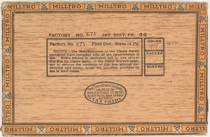
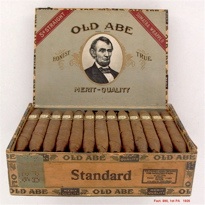
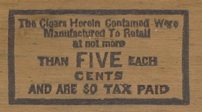

NRA STAMP


If you still have questions
Hyman’s Cigar History Museum contains a complete guide to dating cigar boxes from the U.S., Canada and Cuba. 200+ photos provide the world’s most complete guide to dating boxes from the collectable century (1860-1960). Normally open only to Museum members, the Dating exhibits are currently open to all visitors. See choices at the top of this page.
You can always have complete dating information by ordering the Complete Guide to Dating Cigar Boxes on CD. Information.
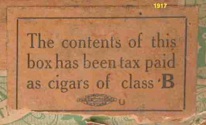
A NOTE ABOUT CANCELLATIONS:
Early laws specified tax stamps be hand cancelled when purchased. Golden Age laws required cancellation by rubber stamp after the stamp was affixed. Starting in 1910, the preferred method of canceling became the two-line machine perforated cancel.
The form was set by law, remained constant as long as stamps were used, and is easy to read. The top line contains the Factory number, tax district and state, the three bits of info separated by centered dots. The bottom line indicates the month, day and year the stamp was applied, each number separated by a dot. The Class A stamp above clearly tells you the cigars were made in Factory 550 located in the first tax district of Pennsylvania, and was cancelled October 6th, 1927. Single digit days are preceded by a cross rather than a zero. That factory number belonged to Bayuk Cigar Co.
Those last two digits can often be read even on severely damaged stamps. Each number is 3 holes wide and 6 high. All you need to see for example is a hole in the lower right corner to know the number was a 1 or a 2, the only numbers using that hole. Be alert for dates printed reversed or upside down.
